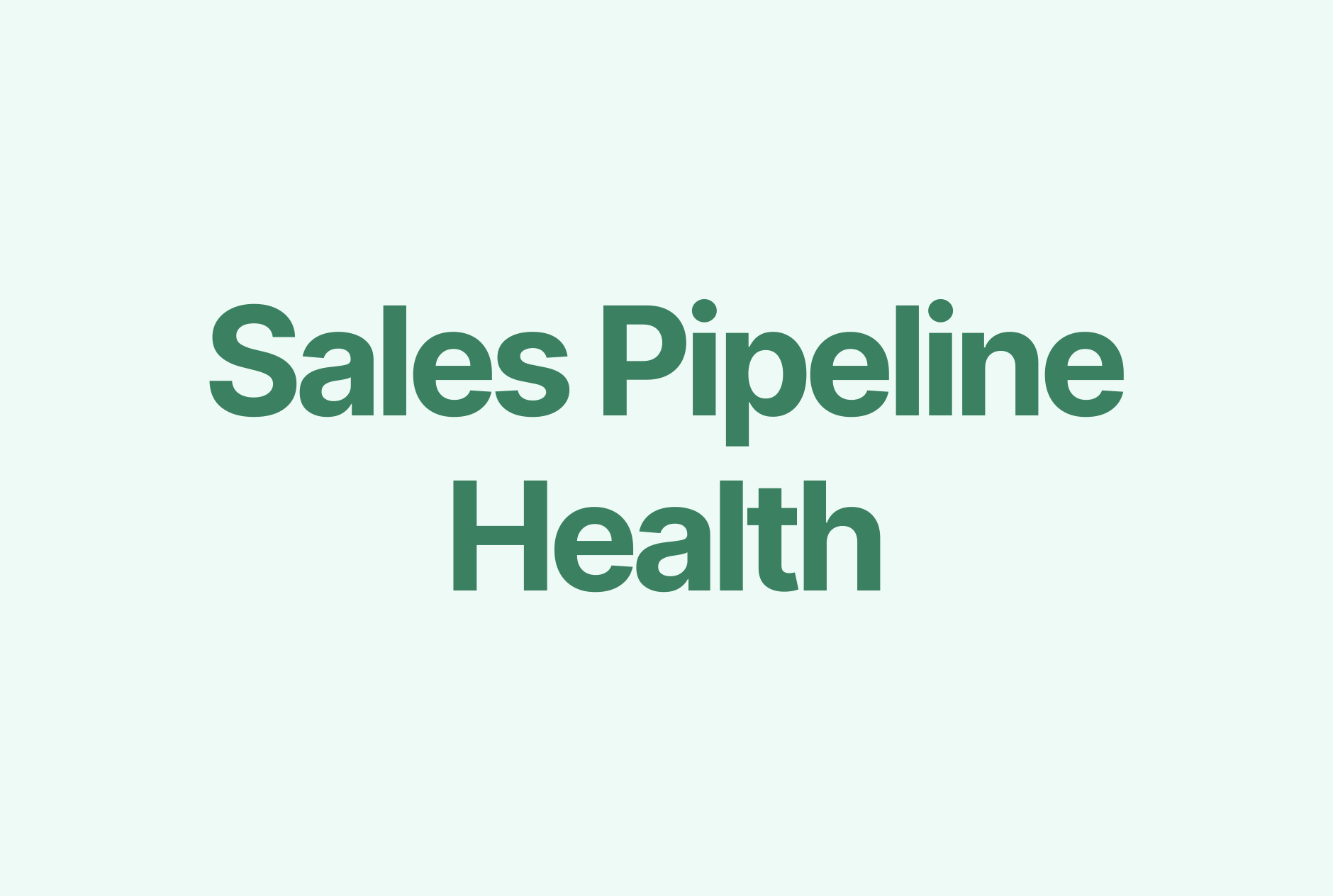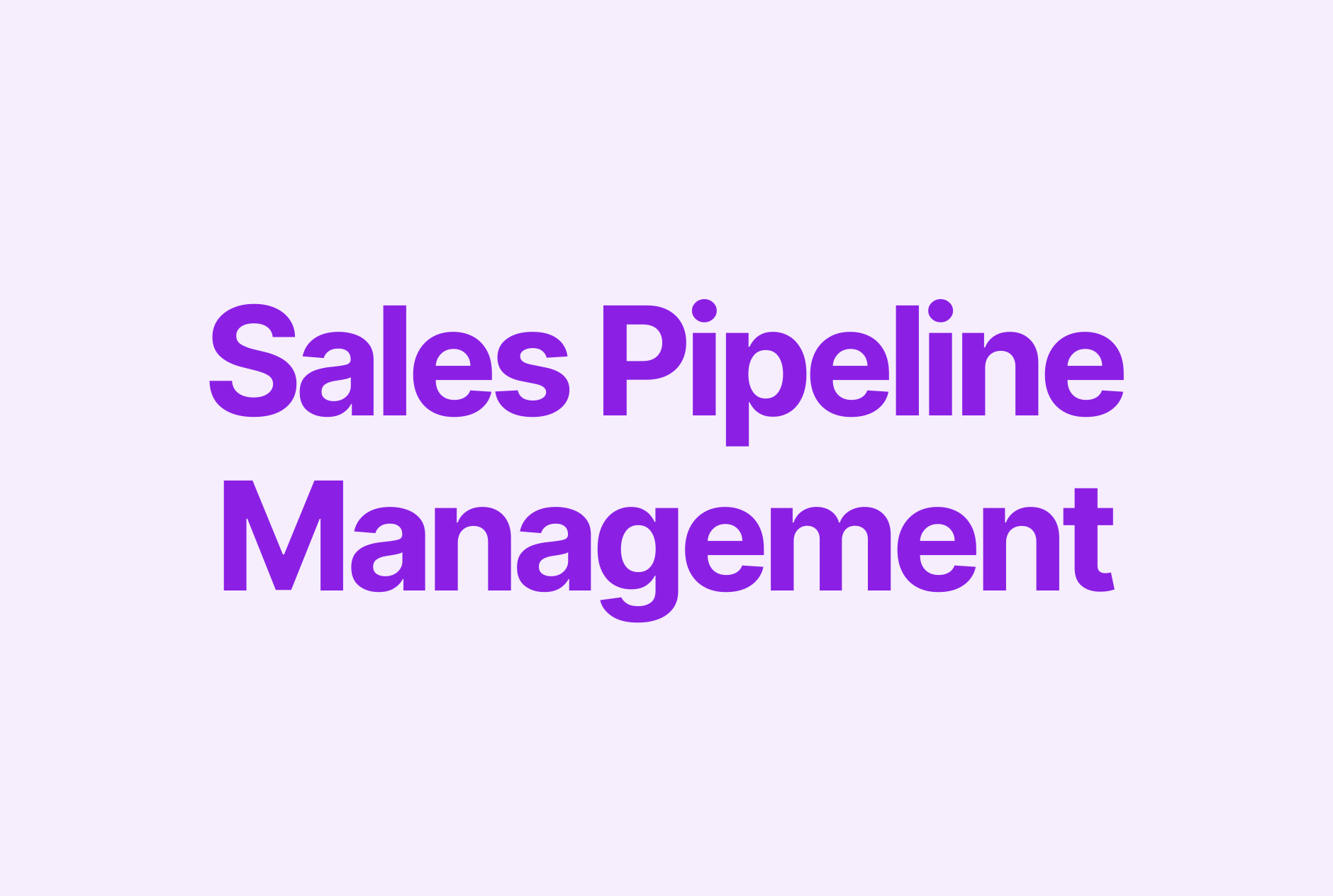15 Sales Pipeline Metrics you Need to Track in 2023

How do you keep track of what's happening with your sales pipeline? By tracking sales pipeline metrics, of course.
In this guide, we'll go over the top 15 sales pipeline metrics you should be tracking.
What are sales pipeline metrics?
Sales pipeline metrics measure the success of your sales pipeline and check for weak spots and opportunities for improvement.
Pipeline metrics are crucial for sales teams and must be understood and tracked by every team member. After all, the pipeline is the journey every lead goes through, and certain metrics can help you understand the different stages, what drives people forward and what pushes them away.
15 sales pipeline metrics you should track
While the exact metrics to track might be different for every team, most sales teams would benefit from tracking these sales pipeline metrics:
#1. Number of Sales Qualified Leads (SQLs) per month
From all the pipeline metrics to track, this is probably the most common one. The best way to calculate this number is to start with your current revenue goals and see how many SQLs and MQLs will be needed to complete these goals.
The period in which you choose to track this depends entirely on you. Some sales managers do it weekly, and others look only at the current quarter.
Doing it every month, however, gives you enough time to gather the data and, if needed, make changes to increase the top of the funnel to get more relevant leads from your marketing and sales efforts.
You also have the freedom to choose whether to look at the overall number of qualified leads or the ones gathered by certain team members.
For smaller companies, it's easier to do this for each salesperson, while larger corporations will find it more suitable to track entire teams.
#2. Number of Marketing Qualified Leads (MQLs) per month
Another thing you can do is check how many of those leads come from different channels and marketing campaigns.
Sales and marketing strategies should always be aligned to increase revenue, so it's very important to track marketing qualified leads.
However, it can be quite risky to solely rely on the absolute number of MQLs as it might give Marketing a wrong incentive - MQL quality is also crucial to effectively build pipeline.
To prevent a wrong turn, start by putting a stringent definition on MQLs through cohort analytics, user personas, or even feedback from your sales teams. After that, you can start analyzing the following data:
- Demographic lead data - This will show the shared characteristics between people who become MQLs and help you define them even more.
- Behavior lead data - This data will show whether people are ready to become SQLs and how they move along the funnel. Looking at their behavior will help your sales team choose the right time to step up.
- Lead engagement factors - For example, spending a lot of time on the pricing and product pages and coming back to the site frequently are signs of a person ready to be approached by a sales rep. Besides website analytics, you should also look at email and social media engagement, as well.
#3. Average Client Acquisition Cost (CAC)
Client acquisition cost is the main factor that B2B companies use to measure their business profitability. It’s something that they are constantly trying to improve through increasing sales efficiency, improving their targeting and prospect qualification process, and retargeting customers.
There are two versions of CAC - Blended and Fully Loaded Customer Acquisition Cost, so naturally, there are two different formulas. Let’s take a look.
- Blended Customer Acquisition Cost
The Blended CAC encompasses all the marketing and sales expenses within a certain period of time, including overhead expenses and salaries, divided by the number of acquired customers within the same period.
It’s called blended because it doesn’t take into account organic customer acquisition, MQLs, referrals, etc. Instead, it focuses on the total costs the company has spent, no matter the channel, in order to gain clients.
- Fully Loaded Customer Acquisition Cost
This is the more commonly used variant because it also includes a lot of other factors that might be included in the customer acquisition process.
The formula is the same, you only have to add everything that you need and divide that by the number of acquired customers.
Remember to always work within a certain period, ideally a month. Sales professionals can use it to track whether a client is profitable by comparing the Fully Loaded CAC with their Customer's Lifetime Value.
#4. CLV:CAC ratio
The ratio between customer lifetime value and customer acquisition cost is an extremely important sales pipeline metric as it’s a lot more holistic than tracking CAC alone.
You can measure it by checking how much it costs to acquire this client and compare it with their customer's lifetime value.
A ratio of 1:1 is the lowest you can go because that means that at the end of the day, the revenue you gain from this customer is equal to the amount you paid to acquire them.
Anything lower than 1:1 is bad for your business, and the customer acquisition cost is just too much. At that point, you need a change in your sales strategy.
You can increase the customer’s lifetime value by improving sales efficiency, offering a referral program, cross selling, rewarding loyal customers, and much more.
#5. Average deal size
Speaking of tracking sales performance, sheer numbers aren't everything. The size of the deal matters just as much, if not more, than the number of closed deals, and that makes it an essential sales pipeline metric.
Check the average value of every team member, which will help you gain a better perspective of how each person contributes to your revenue goals.
The average deal size also affects the sales velocity rate - a large deal requires a slow sales cycle in order to convert the lead, while a smaller one will convert a lot quicker. You can use this information to better understand the types of products that sell easier, how much customers are willing to pay, and if your products are priced correctly.
#6. Number of closed deals per month
Closing deals is naturally what everyone is trying to do, so it makes sense to track the total sales per month. However, remember that a closed deal only counts when you have a signed contract or the client has made the payment.
At the end of every month, track how many leads have turned into paying clients and compare sales rep performance. If a person is outperforming the rest of the team, they are clearly doing something different, and you need to check how to implement their strategies in the sales process.
Similarly, if there are people that constantly underperform without any legitimate reasons, think about whether they are worth the investment.
This metric is best combined with the one that tracks the average deal size per employee/time period.
#7. Average sales cycle length
The sales cycle begins at the initial contact and ends with a sale and a signed contract. We recommend using this sales metric to compare how long it takes for different sales representatives to sell the same service.
If the difference is only a day or two, you have nothing to worry about. Still, if one person takes around 7 working days while another has an average sales cycle length of 14 days, then you'll probably have to investigate.
Another way you can use this metric is to compare the different products you offer.
For example, one might be selling quickly, and the process only takes a few days, while another requires at least a week. If that's the case, you have a weak spot in your sales strategy for that product, and you need to figure out a new way to sell it or change the product itself.
And lastly, combined with your lead volume, the cycle length can be used in sales forecasting so you can make predictions about upcoming quarters.
#8. Sales pipeline velocity
Sales velocity measures how quickly a prospect moves through the sales funnel. This metric can help you calculate future revenue and the efficiency of the various stages of your pipeline.
In that sense, it’s similar to the average sales cycle length, because the less time your lead spends in the pipeline, the better.
It means you can start spending resources on a different lead much sooner. There is a formula for this, and you can use it to see how much money is going through your pipeline on a daily basis.
#9. Opportunity Win Rate
Conversion rate is essential for business growth. It is the main thing that drives your company forward, which is why your win rate is such an important metric to track.
Make sure you track each individual sales representative's conversion rate to see their weak spots and whether they need training and guidance. If someone from your sales team has a high number of SQLs but doesn't manage to convert them, then they definitely need to change their tactic and improve their sales effectiveness.
#10. Customer Churn Rate
This metric is used to measure how many of your current paying customers decide to opt out of your services. It's very useful for businesses that rely on repeated purchases, such as SaaS companies with a subscription model.
Client churn rate can show weak spots in the ways that you deliver your product or service. It could be bad customer support teams, changes in prices, bad user experience, and much more. A high churn rate means that you need to work on your product. In that case, the most helpful tactic is to collect churn reasons and thoroughly analyze them.
Another thing you can do is try to see whether the rise of customer churn followed a recent business change, such as a rise in prices or a vital change in the product that you offer. Noticing these trends on time will help you predict how much revenue you can expect in the future and, through changes, increase the customer lifetime value instead of decreasing it.
#11. Age of Sales Opportunities
This is a very simple but effective metric that you need to use when you feel like a prospect is taking forever to make a decision. Generally, the more time your prospects spends in the pipeline, the smaller the chance to convert them into paying customer.
Check how much time has passed since this particular lead has been in the pipeline, and, most of all, at which stage they got stuck. Then, try to understand the reasons behind their inability to commit and decide whether nurturing this person is worth it.
#12. Sales to Support Ratio
This metric will show you how difficult it is for prospects to use your product. Many businesses include a free trial or an onboarding session before a purchase is made, so what you need to track here is the number of times the lead required help in order to understand your product or service.
If they can't use a feature and are in constant need of support, either the product needs to be fixed, or your sales representative did not do a good job of explaining the process.
#13. Revenue Growth by Product Line (or Sales Team)
This is a very important metric for your sales teams and product development department. If you offer multiple products or services, you need to check which ones are performing the best and attracting a larger number of sales-qualified leads. This specific product or service is your golden ticket, and you can use that information to help your sales and marketing teams increase customer acquisition by fulfilling the needs of your target market.
Similarly, if some of your products and services are not selling as much as they should, there is obviously room for improvement, and you can start working on making them better. This information is vital for your product development teams to make the necessary changes and remove that feature or product entirely if it's not worth it.
#14. Deal Loss Reasons
Finally, you need to take a look at all of the lost deals and try to understand what went wrong. Winning is important, but you can learn as much, if not more, from the losses that you've endured.
The most useful strategy here is to track those reasons gathered from meetings in a seamless CRM such as Weflow and analyze them monthly or quarterly.
When you make changes based on those reasons, set up a separate tracking system to see whether the results from that change are positive or negative. It’s a good idea to organize this with your sales agents as they are on the first line with clients and will be able to give you valuable feedback.
#15. Deal drop-off by stage
This is very similar to the deal loss reasons metric but it pays attention to the sales pipeline stage where the drop-off occurred. Pay attention to every prospect that decides to leave the pipeline and check whether a large number of them are leaving at the same stage.
If possible, send out a feedback form or just instruct your sales teams to ask the reason for the prospect's decision to stop the process.
Boost your sales process
Tracking so many metrics at different parts of your pipeline can be quite overwhelming, stressful, and most of all - time-consuming.
Research from Salesforce confirms that salespeople spend only around 34% of their time actually selling, while the rest is spent trying to organize their workflow and track performance.
With Weflow, you can take back your time and pay attention to the things that truly matter - growing your business and creating a positive experience for your current and future clients. Get started for free today!













